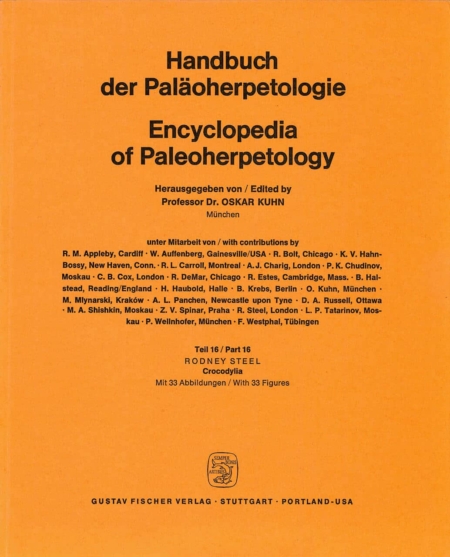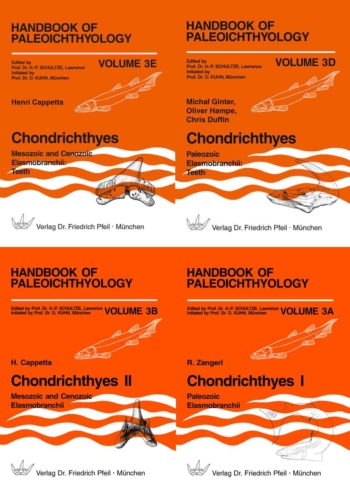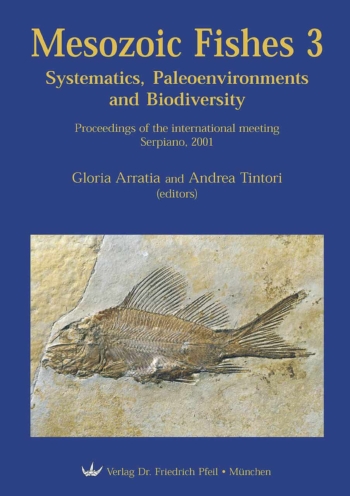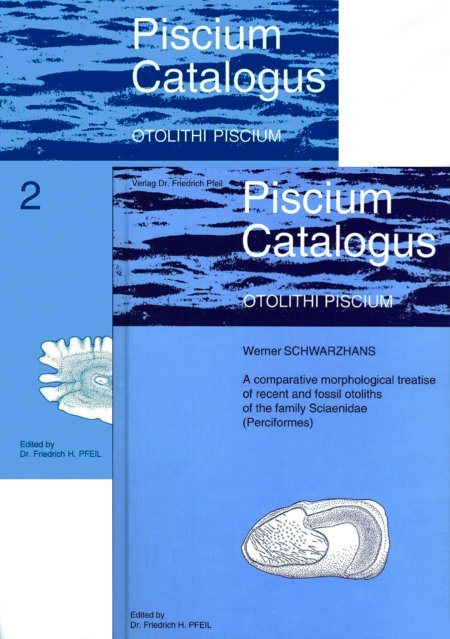Order Crocodylia GMELIN 1788 1
Suborder Protosuchia MOOK 1934 6
Family Sphenosuchidae HUENE 1922 6
Family Protosuchidae BROWN 1934 7
Suborder Archaeosuchia ROMER 1966 10
Family Notochampsidae HAUGHTON 1924 10
Family Proterochampsidae ROMER 1966 11
Suborder Mesosuchia HUXLEY 1875 12
Family Atoposauridae GERVAIS 1871 12
Family Goniopholididae COPE 1875 14
Family Paralligatoridae KONJUKOVA 1954 19
Family Notosuchidae DOLLO 1924 20
Family Libycosuchidae STROMER 1914 21
Family Sphagesauridae KUHN 1968 22
Family Hsisosuchidae YOUNG & CHOW 1953 22
Family Teleosauridae COPE 1871 23
Family Pholidosauridae WILLISTON 1902 35
Family Congosauridae DOLLO 1914 38
Suborder Thalattosuchia E. FRAAS 1902 41
Family Metriorhynchidae FITZINGER 1843 41
Suborder Sebecosuchia SIMPSON 1937 50
Family Sebecidae SIMPSON 1937 50
Family Baurusuchidae PRICE 1945 51
Suborder Eusuchia HUXLEY 1875 53
Family Hylaeochampsidae WILLISTON 1925 53
Family Bernissartiidae LYDEKKER 1887 53
Family Stomatosuchidae STROMER 1925 54
Family Aegyptosuchidae KUHN 1936 55
Family Crocodylidae CUVIER 1807 55
Subfamily Crocodylinae CUVIER 1807 57
Subfamily Alligatorinae KÄLIN 1940 72
Subfamily Pristichampsinae KUHN 1968 89
Subfamily Thoracosaurinae NOPCSA 1928 90
Subfamily Gavialinae NOPCSA 1923 96
Family Nettosuchidae LANGSTON 1965 101
Bibliography 103
Index 111
HPH 16 • Crocodylia
1973. [English] – VII, 116 pp., 33 figures.
25.5 x 20.5 cm, paperback.
Series: Handbook of Paleoherpetology
40,00 €
plus shipping costs
Order Crocodylia GMELIN 1788
(Includes Loricata MERREM 1820, Loricati WIEGMANN & RUTHE 1843, Emydosauri GRAY 1825, Emydosaura GRAY 1838, Emydo-Sauri LATREILLE 1825, Emydosauria BLAINVILLE 1825, Crocodilia OWEN 1842, Crocodilomorphi HAY 1930, Crocodiloidea FITZINGER 1826, Crocodiloidei ERCHWALD 1831, Crocodiluri FITZINGER 1843, Crocodilia vera LYDEKKER 1887, Aspidiotes DuMERIL & BIBRON 1836, Aspidota JAN 1857, Dactylopodes MEYER 1845)
Archosaurian reptiles of quadrupedal habit (perhaps secondarily) and essentially aquatic proclivities. External nares terminal, antorbital fenestra usually reduced or absent. Otic notch region becoming closed by union of squamosal and quadrate to contain the middle- and inner-ear cavities in a deep pocket; quadrate large with the well-developed quadratojugal running upward along its anterior margin. A secondary palate is present, formed by the palatines and (in advanced forms) the pterygoids as well. Basicranial region highly ossified but pneumatic, part or all of the eustachian passages being enclosed in bone; epipterygoid absent, pterygoid and quadrate broadly fused to braincase. Supraoccipital small and excluded from foramen magnum. Posttemporal fenestrae reduced, opisthotic broadly united laterally with both quadrate and squamosal. No prearticular element in lower jaw, mandibular fossa widely open medially. Teeth typically thecodont, often with development of anterior and posterior keels.
Characteristically about 23 or 24 presacral vertebrae (including 9 cervicals), with centra becoming procoelous in advanced forms. Atlas intercentrum and axis intercentrum fused (the two sometimes becoming joined to the axis as an odontoid), proatlas elements co-ossified. Neural spines well developed throughout column, caudal centra (other than the biconvex first member of the series) remaining persistently platycoelous. Dorsal transverse processes horizontally located, and in posterior dorsals bearing the capitular facet (which fuses with the tubercular facet). Terminal presacral ribs conjoined to transverse processes. Caudals exhibiting both neural and haemal spines.
An interclavicle is present, but the clavicles themselves are suppressed; coracoid elongate postero-ventrally and containing a foramen. Pelvis typically tri-radiate with a large partially perforate acetabulum from which the pubis is progressively excluded by an anterior extension of the ischium. There is no obturator foramen.
Pectoral limbs shorter than hind to a varying degree; fore arm greatly abbreviate, crus short. Femur lacking a projecting fourth trochanter and exhibiting no development of a greater trochanter. Digit V of pes reduced to a short metapodial. Dermal armour commonly (though not invariably) present, typically including a paired series of dorsal plates, a ventral plastron of numerous small scutes, and a tail sheath.
Middle Triassic to Recent.
The two principal crocodilian groups revealed by a study of fossil and Recent forms are divisible horizontally into the suborders Mesosuchia and Eusuchia. The former are extinct and may be distinguished primarily by the less comprehensive development of a secondary palate (composed only of the premaxillae, maxillae and palatines) and the retention of platycoelous vertebrae; in eusuchians the pterygoids also contribute to the secondary palate and the presacral vertebrae become procoelous. Additional suborders have been erected to include the apparently exclusively aquatic marine crocodiles of the Mesozoic (Thalattosuchia) and the possibly rather specialised Sebecosuchia (which may have been largely terrestrial forms), together with two groups of primitive Triassic forerunners (the Protosuchia and the Archaeosuchia) that are in many cases difficult to distinguish from contemporary thecodonts.
WALKER (1970) considered that Hal/opus victor (usually considered to be a saurischian dinosaur) was a cursorial crocodilian representative of an evolutionary line that …
You must be logged in to post a review.
"*" indicates required fields
Related products
We’re here for you
Verlag Dr. Friedrich Pfeil
Hauptstraße 12B
5232 Bergkirchen OT Günding – Germany
Tel.: +49 8131 61 46 590
Fax: +49 8131 61 46 591
E-Mail: info@pfeil-verlag.de
Contact
Tel.: +49 89 742827-0
Fax: +49 89 7242772
E-Mail: info@pfeil-verlag.de






Reviews
There are no reviews yet.